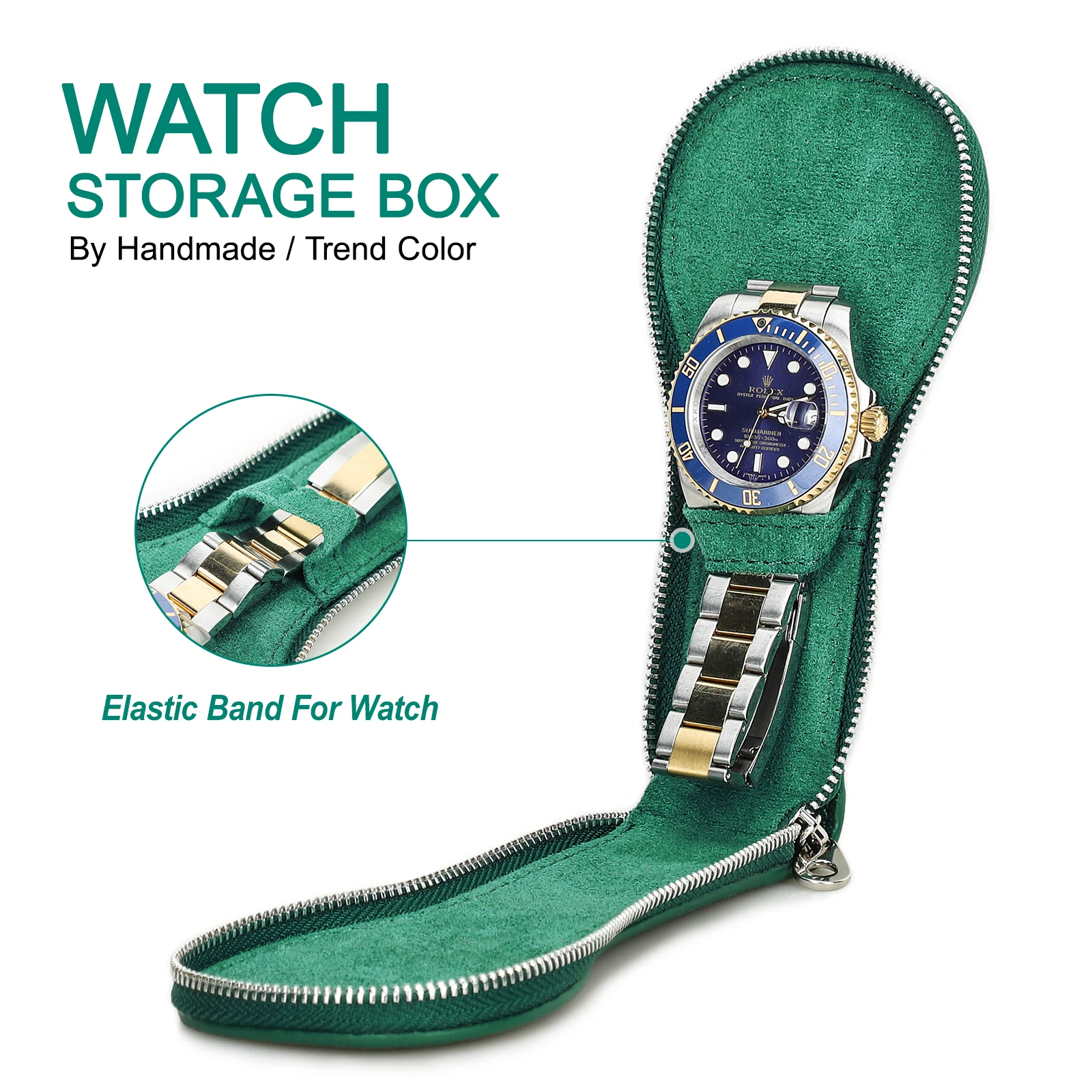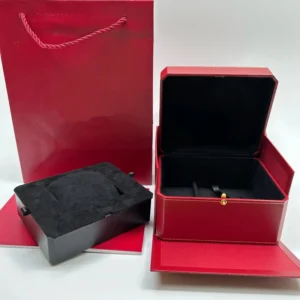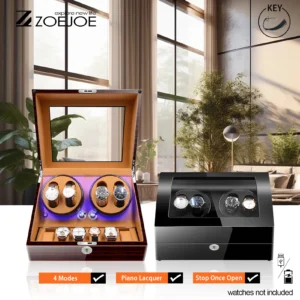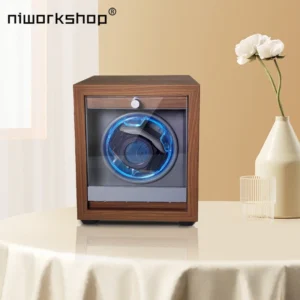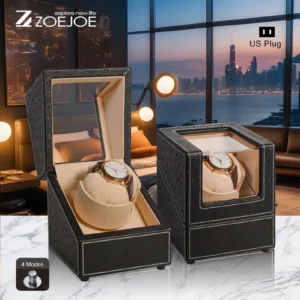Understanding Watch Winders and Their Importance for Automatic Watches
A watch winder is a mechanical device specifically designed to keep automatic watches running when they’re not being worn. These ingenious tools simulate the natural motion of your wrist, gently rotating your timepiece to maintain its power reserve and functionality.
Automatic watches rely on movement to stay wound. When you wear your watch, the natural motion of your arm causes an internal rotor to spin, which winds the mainspring and stores energy. Without this regular movement, your automatic watch will eventually stop running—typically within 36-72 hours depending on its power reserve.
Using a compatible watch winder offers several crucial benefits:
- Maintains proper lubrication throughout the movement, preventing oil from settling or congealing
- Ensures your watch displays accurate time whenever you decide to wear it
- Reduces wear and tear that comes from repeatedly setting the time and date
- Extends the lifespan of your timepiece by keeping components in regular motion
For optimal performance and longevity of your valuable timepiece, understanding programming basics for automatic watch winders is essential. The right compatibility settings make the difference between proper care and potential damage to your watch.
When automatic watches sit motionless for extended periods, their lubricants can settle in ways that affect accuracy and may eventually lead to increased friction between components. A properly configured winder prevents these issues while showcasing your beautiful timepieces.
Whether you have a single luxury watch or an extensive collection, choosing the right automatic watch winder requires understanding the specific needs of your timepieces.
How Automatic Watches Work: The Mechanism Behind Self-Winding Timepieces
Automatic watches represent a fascinating blend of engineering and artistry. Unlike quartz watches that run on batteries or manual watches that require daily hand-winding, automatic watches harness the natural movements of your wrist to power themselves.
At the heart of every automatic watch is a mechanical movement featuring an oscillating weight (also called a rotor). This semi-circular metal piece pivots freely around a central axis. When you move your arm, the rotor spins, transferring energy through a series of gears to wind the mainspring—the watch’s power source.
As the mainspring gradually unwinds, it releases stored energy that powers the watch’s escapement, which regulates the movement of the hands. This delicate system maintains accurate timekeeping as long as sufficient tension remains in the mainspring.
Most automatic watches have a power reserve ranging from 36 to 72 hours, though some premium models can run for days longer. Once this reserve depletes, the watch stops until motion resumes.
It’s important to note that watch winders are designed specifically for automatic watches. They serve no functional purpose for quartz watches (which run on batteries) or manual-wind watches (which must be hand-wound).
When an automatic watch stops completely due to lack of motion, it doesn’t cause immediate damage. However, frequent stops and starts can cause unnecessary wear on components and allow lubricants to settle unevenly. Understanding TPD settings for watch winders is crucial for maintaining your timepiece’s optimal performance.
Essential Compatibility Factor: Turns Per Day (TPD)
TPD, or Turns Per Day, represents the number of complete rotations a watch winder should perform within a 24-hour period to adequately wind an automatic watch. This specification is arguably the most crucial compatibility factor to consider when using a watch winder.
Different watch movements have different winding requirements based on their specific design, weight of the rotor, and mainspring characteristics. Using the wrong TPD setting can lead to several problems:
Underwinding Issues:
– Insufficient power reserve, causing the watch to stop unexpectedly
– Inconsistent timekeeping due to inadequate mainspring tension
– Potential lubrication issues as components aren’t moving enough to distribute oils
Overwinding Concerns:
Contrary to popular belief, modern automatic watches have slip mechanisms that prevent true “overwinding” damage. However, excessive winding can still cause:
– Unnecessary wear on the slip mechanism itself
– Potential stress on the winding components
– Reduced service life of internal parts
– Wasted energy from the winder motor
Most automatic watches fall within these general TPD ranges:
– Low-requirement movements: 500-650 TPD
– Standard movements: 650-850 TPD (most common)
– High-requirement movements: 850-1200 TPD
– Specialized movements: 1200+ TPD (relatively rare)
You might notice your watch is receiving incorrect TPD if it stops despite being in the winder, runs fast or slow, or doesn’t maintain its expected power reserve. Having a deeper understanding of TPD mechanics will help you ensure your timepiece receives exactly the winding it needs.
Manufacturers like Rolex, Omega, and Breitling typically provide TPD recommendations in their documentation, though these can vary even within the same brand depending on the specific movement used. Always consult your watch’s documentation or the manufacturer’s website for the most accurate information.
Rotation Direction: Understanding Clockwise, Counter-Clockwise, and Bi-Directional Winding
The direction in which a watch winder rotates is just as important as the TPD setting. Automatic watches are designed with specific winding mechanisms that respond differently to directional movement:
Clockwise-Only Winding Mechanisms:
These watches have rotors that only capture energy when moving in a clockwise direction. Placing these timepieces in a counter-clockwise or bi-directional winder at the wrong setting would result in inefficient winding or no winding at all.
Counter-Clockwise-Only Winding Mechanisms:
Similar to their clockwise counterparts, these watches only wind when the rotor moves counter-clockwise. Using the incorrect direction setting would render the winder ineffective.
Bi-Directional Winding Mechanisms:
Most modern automatic watches feature this design, allowing the rotor to capture energy regardless of which direction it moves. These watches can be placed in any directional setting, though many experts recommend matching bi-directional winders with bi-directional watches for optimal efficiency.
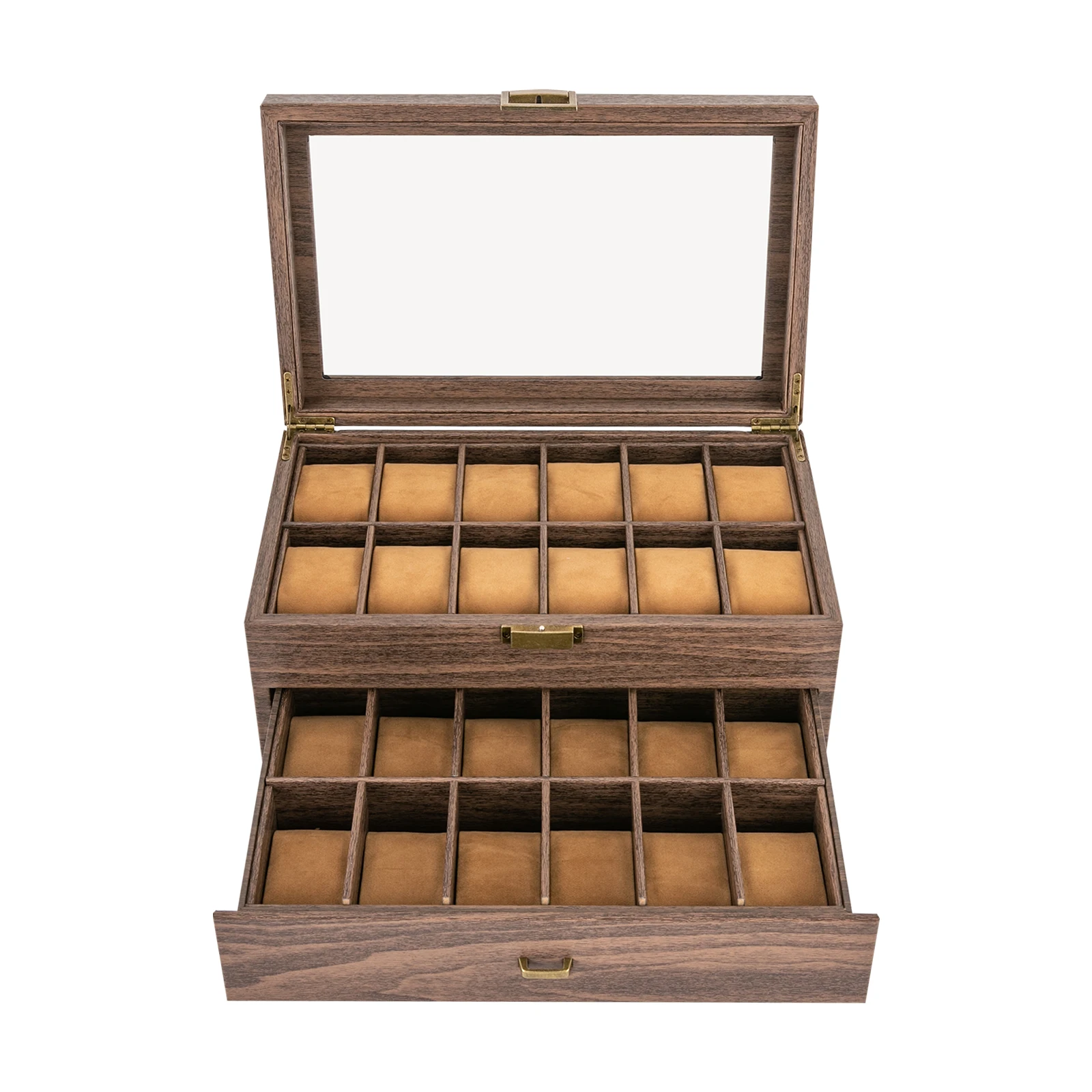
To determine your watch’s winding direction, you can:
1. Consult the manufacturer’s documentation
2. Observe the rotor movement through the case back (if visible)
3. Research your specific movement online
4. Ask a watchmaker familiar with your timepiece
Premium watch winders often offer customizable direction settings to accommodate different types of watches. Understanding the ultimate guide to automatic watch winder settings will help you configure these devices properly.
Using the incorrect rotation direction won’t damage your watch immediately, but it can lead to ineffective winding and the same issues associated with underwinding mentioned in the previous section. For collectors with multiple watches having different requirements, multi-position winders with individual settings become particularly valuable.
Physical Compatibility: Watch Size, Weight and Cushion Fit
Beyond the mechanical settings, the physical fit between your watch and the winder is crucial for both security and protection. An improperly fitted watch may slip, shift, or even fall within the winder, potentially causing damage.
Standard watch cushions typically accommodate watches with case diameters between 32mm and 45mm, though dimensions vary between manufacturers. For oversized watches (those exceeding 44mm), specialized cushions or winders designed for larger timepieces may be necessary.
Watch thickness also matters, particularly for watches with substantial depth or protruding crowns. Most standard winders accommodate watches up to about 15mm thick, but again, this varies by model.
Weight is another important consideration. Heavier watches (typically those with solid metal bracelets or large case sizes) can put additional strain on winder motors. Quality winders are designed to handle this extra weight, but budget models might struggle with particularly heavy timepieces.
When placing your watch on the cushion, ensure:
– The watch sits centered and level
– There is no excessive movement or shifting when the winder operates
– The strap or bracelet is securely fastened around the cushion
– The crown doesn’t press against any part of the winder
Warning signs of poor physical fit include:
– Rattling or unusual sounds during operation
– The watch sliding to one side of the cushion
– The watch stopping despite the winder operating correctly
– Visible stress on the watch band or bracelet
For collectors with various strap types, having appropriate watch pillows can make a significant difference in fit and security. Some cushions are specifically designed for metal bracelets, while others accommodate leather or rubber straps more effectively.
A proper physical fit not only ensures effective winding but also prevents potential cosmetic damage from unwanted movement or contact with the winder’s interior surfaces.
Winding Cycles and Rest Periods: Mimicking Natural Wrist Movement
Quality watch winders don’t simply rotate continuously—they’re designed to mimic the natural patterns of human wrist movement. This is achieved through programmed cycles of rotation and rest periods that more accurately reflect how a watch would be wound during normal wear.
In reality, when wearing a watch, your wrist isn’t in constant motion. You have periods of activity interspersed with periods of rest. The best winders replicate this pattern through intermittent winding rather than continuous rotation.
Typical winding cycle patterns might include:
– 5 minutes of rotation followed by 30 minutes of rest
– 10 minutes of rotation followed by 90 minutes of rest
– Custom cycles based on specific watch requirements
These programmed rest periods serve several important functions:
1. They prevent potential excessive wear on the winder motor
2. They more accurately simulate natural wearing patterns
3. They allow the watch’s power reserve to function as designed
4. They reduce unnecessary stress on the watch’s winding mechanism
Higher-end winders often feature adjustable duty cycles, allowing you to customize not just the TPD and direction, but also the specific pattern of rotation and rest. Understanding how watch winder rotation cycles work can help you select the optimal pattern for your specific timepiece.
The goal is to maintain adequate power in the mainspring without subjecting the watch to more winding than necessary. For most watches, achieving the correct TPD through intermittent cycles provides the best balance between keeping the watch ready to wear and minimizing unnecessary mechanical activity.
Finding Your Watch’s Specific Winding Requirements
Determining the exact winding requirements for your automatic watch is essential for proper care and maintenance. Here are the primary sources for this crucial information, in order of reliability:
Watch User Manual/Documentation
The manufacturer’s documentation that came with your watch often contains specific winding requirements, including TPD and direction recommendations. Check the care and maintenance section for these details.Manufacturer’s Official Website or Customer Support
Many watch brands maintain online resources with technical specifications. If not readily available on their website, contacting customer support with your watch model number can yield accurate information.TPD Databases and Resources
Several online databases compile winding requirements for popular watch movements and brands. While not official sources, these can provide good starting points, especially for common movements.Watch Forums and Communities
Fellow enthusiasts often share their experiences and manufacturer-provided information. Communities like WatchUSeek, Reddit’s r/Watches, or Omega Forums can be valuable resources.
When researching your watch’s requirements, look specifically for:
– The recommended TPD range (not just a single number)
– The winding direction (clockwise, counterclockwise, or bi-directional)
– Any special recommendations for your specific model
For watches with common movements, you can often find guidance based on the movement type rather than the specific watch model. For example, watches containing ETA 2824 movements generally have similar winding requirements despite being used in different brands and models. Understanding winder settings by movement type can be particularly helpful in these cases.
If you cannot find specific information for your watch, a conservative approach is best: start with a middle-range TPD setting (around 650-750 TPD) on a bi-directional setting, then monitor your watch’s performance and adjust accordingly.
Setting Up Your Watch Winder Correctly
Once you’ve determined your watch’s specific requirements, proper setup is essential to ensure effective winding and protection. Follow these steps for optimal results:
Pre-wind your watch manually
Before placing your watch in the winder for the first time, manually wind it (if applicable for your model) or wear it for a few hours to build up an initial power reserve. This gives the winder a “head start.”Configure the winder settings
Set the TPD according to your research, typically using dials or digital controls on the winder. Also set the correct rotation direction (clockwise, counterclockwise, or bi-directional).Prepare the cushion
Ensure the cushion or holder is the appropriate size for your watch. Some winders come with adjustable or different-sized cushions.Mount your watch securely
Place your watch on the cushion with the dial facing outward (for display purposes) or according to the winder manufacturer’s recommendation. Secure the strap or bracelet around the cushion without overtightening.Position the winder properly
Place the winder on a stable, level surface away from:
– Direct sunlight (which can fade watch dials)
– Magnetic fields (from speakers, certain electronic devices)
– Extreme temperature fluctuations
– High humidity areas
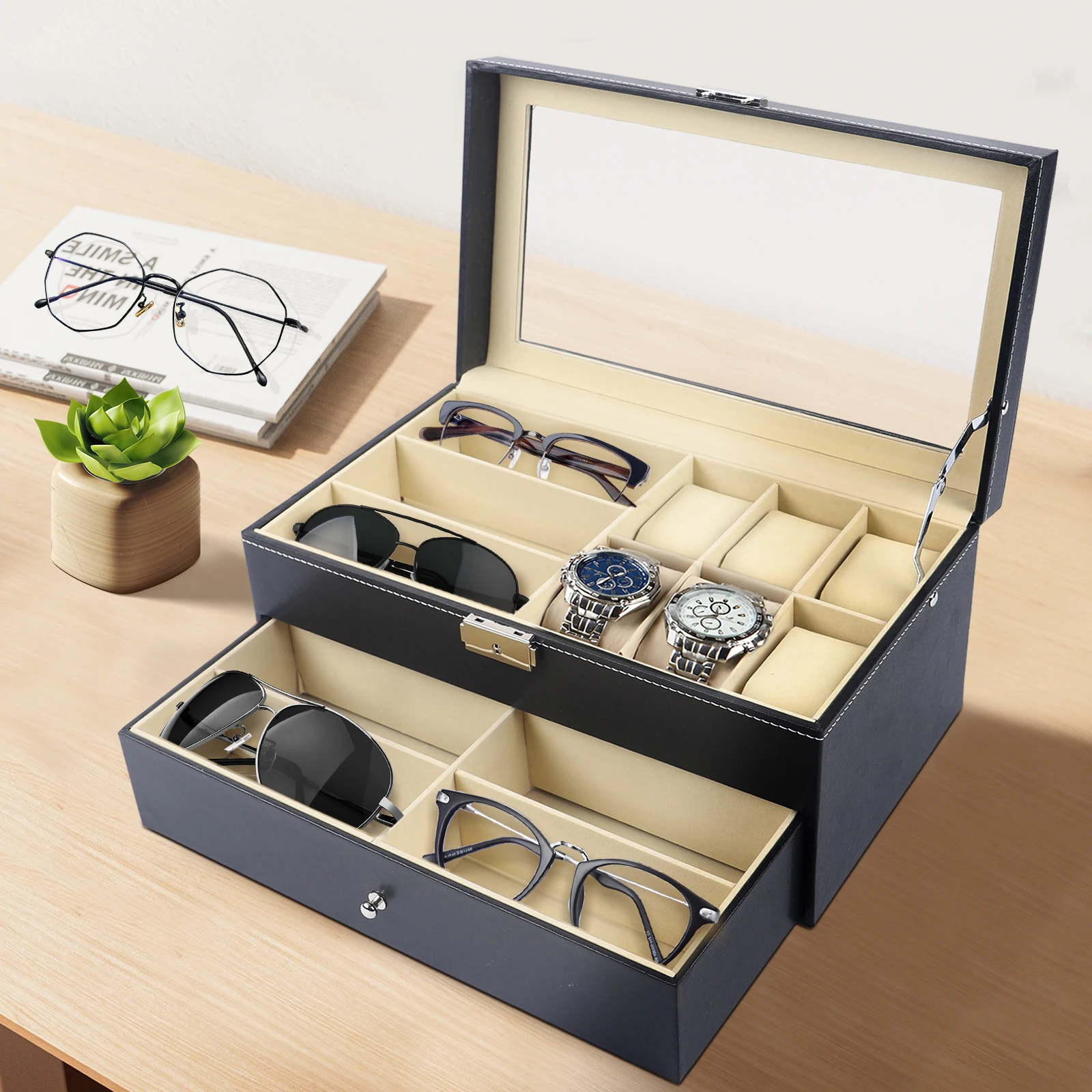
Ensure proper power supply
If using an AC adapter, secure the cord to prevent accidental disconnection. For battery-powered winders, use fresh batteries and check them regularly.Monitor initial performance
During the first 48 hours, check your watch periodically to ensure it’s maintaining accurate time and the winder is functioning as expected.
For a complete step-by-step guide for proper winder programming, consult specific instructions for your winder model, as control interfaces vary significantly between manufacturers and price points.
Troubleshooting Common Compatibility Issues
Even with careful setup, you might encounter issues with your watch winder. Here are solutions to common compatibility problems:
Watch stops despite being in the winder
Potential causes:
– Incorrect TPD setting (usually too low)
– Wrong rotation direction
– Poor cushion fit allowing the watch to shift position
– Winder motor malfunction or power interruption
– Watch itself may need servicing
Solutions:
– Increase TPD setting incrementally (by about 100 TPD)
– Try changing direction settings (from single direction to bi-directional)
– Adjust cushion fit or try a different cushion style
– Test winder with another watch to determine if it’s a winder issue
– If problems persist, have your watch examined by a watchmaker
Watch runs too fast or slow
Potential causes:
– Watch may need regulation or service
– Watch might be magnetized
– Winder may not be maintaining proper tension in the mainspring
Solutions:
– First, test the watch off the winder for 24-48 hours to see if the issue persists
– If accuracy improves off the winder, adjust your TPD settings
– If accuracy issues continue regardless of the winder, consult a watchmaker
Excessive winder noise
Potential causes:
– Low-quality motor
– Watch not secured properly, causing rattling
– Winder not on a stable surface
– Internal mechanism issue
Solutions:
– Place the winder on a soft cloth to reduce vibration
– Ensure the watch is properly secured on the cushion
– Move the winder away from walls or other surfaces that might amplify sound
– For persistent motor noise, contact the winder manufacturer
For more difficult issues, a comprehensive troubleshooting guide for winder issues can help identify and resolve specific problems. Remember that some problems may indicate issues with the watch itself rather than the winder, particularly if the watch is overdue for service.
Choosing the Right Watch Winder for Your Collection
Selecting the appropriate watch winder involves considering both compatibility features and quality factors. Here’s what to look for when making this important investment:
Essential Compatibility Features:
– Programmable TPD settings with a wide range (ideally 300-1800 TPD)
– Multiple rotation direction options (clockwise, counterclockwise, and bi-directional)
– Quality cushions that can accommodate various watch sizes and bracelet types
– Adjustable winding cycles and rest periods
– Proper cushion size and design for secure watch placement
Quality and Convenience Factors:
– Motor quality (quieter operation generally indicates better construction)
– Power source options (AC adapter with battery backup is ideal)
– Construction materials (solid woods, quality metals, and genuine leather offer better protection)
– Capacity options based on collection size (single, double, or multi-watch configurations)
– Warranty length and company reputation
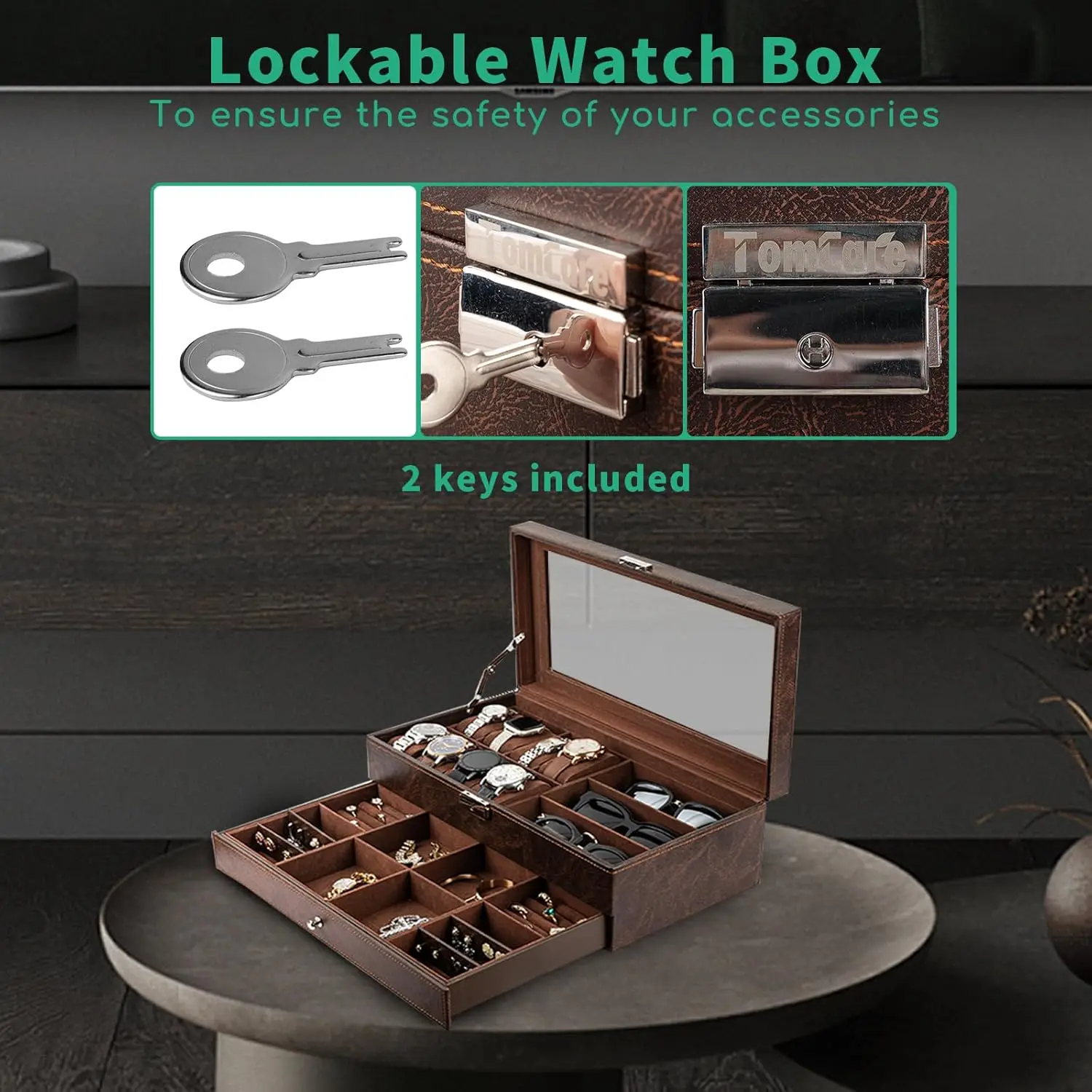
When evaluating winders, remember that this device will be responsible for maintaining valuable timepieces. While budget options exist, winders in the middle to premium range typically offer the programmability and reliability needed for proper watch care.
Warning signs of low-quality winders include:
– Fixed, non-adjustable TPD settings
– Loud operation or vibration during use
– Flimsy cushions that don’t secure watches properly
– Limited or no programming options
– Poor customer reviews mentioning reliability issues
For collectors with diverse timepieces, luxury watch winder options with individual settings for each watch position offer the most versatility and protection.
Luxury Watch Boxes, Men's Watch Boxes, Single Watch Box
Price range: $903.35 through $980.97 Select options This product has multiple variants. The options may be chosen on the product pageAutomatic Watch Winder, Luxury Watch Winder, Single Watch Box
$307.39 Select options This product has multiple variants. The options may be chosen on the product pageLuxury Watch Boxes, Luxury Watch Travel Case
Price range: $200.33 through $224.57 Select options This product has multiple variants. The options may be chosen on the product page4 Watch Winder, 6 Watch Box, Automatic Watch Winder
$512.31 Select options This product has multiple variants. The options may be chosen on the product pageAutomatic Watch Winder, Single Watch Winder, Wooden Watch Holder
$201.76 Select options This product has multiple variants. The options may be chosen on the product pageAutomatic Watch Winder, Leather Watch Travel Case, Single Watch Winder
$146.30 Select options This product has multiple variants. The options may be chosen on the product page
The investment in a quality winder should be proportional to the value of your watch collection—those with fine timepieces should consider winders with premium materials and superior mechanical components to ensure proper care.
Do Watch Winders Damage Automatic Watches? Separating Fact from Fiction
A common concern among watch enthusiasts is whether continuous use of watch winders might cause premature wear or damage to automatic timepieces. Let’s address some common misconceptions:
Myth: Watch winders cause overwinding damage
Reality: Modern automatic watches have mainspring slip mechanisms that prevent true overwinding damage. Once the mainspring reaches full tension, these mechanisms allow the rotor to continue turning without adding more tension.
Myth: Watches in winders wear out faster
Reality: Proper winding actually helps maintain even lubrication throughout the movement. Watches that sit still for extended periods can develop dry spots in the lubricant, potentially causing more wear when eventually used.
Myth: Watches should never be in winders long-term
Reality: Quality winders with proper settings (correct TPD, direction, and rest cycles) closely mimic natural wearing patterns and are generally safe for long-term use.
That said, many watchmakers do recommend occasionally giving watches a complete rest period. This practice isn’t because winders cause damage, but rather because:
- It allows components to naturally rest in different positions
- It creates a clear delineation point for tracking accuracy over time
- It helps identify when service might be needed (a properly maintained watch should start easily and run accurately)
Understanding appropriate winder usage scenarios helps balance convenience with optimal watch care. For most collectors, using winders for regularly worn pieces while allowing rarely worn pieces to rest (winding them manually when needed) represents a practical middle ground.
Protecting Multiple Watches: Multi-Winder Compatibility Considerations
Collectors with multiple automatic watches face additional compatibility challenges when using multi-watch winders. Here are important considerations when winding diverse collections:
Mixed TPD Requirements
When watches with different winding needs share the same winder, you’ll need to make strategic decisions:
– Group similar watches with comparable TPD needs
– Use modular or multi-position winders with individual settings for each position
– Prioritize correct settings for more sensitive or valuable pieces
Direction Challenges
Multi-watch winders typically offer three approaches:
– Single direction for all positions (limiting compatibility)
– Bi-directional for all positions (works for most modern watches)
– Individual direction control for each position (optimal but typically found only in premium units)
Rotation Scheduling
For collections larger than available winder positions:
– Develop a rotation schedule for watches not in regular wear
– Consider which watches benefit most from continuous winding
– Reserve winder positions for complicated watches (perpetual calendars, moon phases) that require significant resetting
The best solution for serious collectors is often a modular high-end winder system that allows for expansion and individual control of each position. These systems, while more expensive initially, provide the flexibility needed as collections evolve and grow.
Alternative Solutions When Perfect Compatibility Cannot Be Achieved
Sometimes, despite best efforts, perfect compatibility between your watches and available winders may not be possible. Here are practical alternatives:
For Watches with Unusual Requirements:
– Consider specialized single-watch winders programmed specifically for that piece
– Use a programmable winder with the closest possible match to requirements, then monitor performance
– Consult with watch specialists about custom solutions for rare or vintage pieces
For Vintage Watches:
– Many vintage watches lack the slip mechanisms of modern automatics and may need more careful winding
– Consider manual winding on a regular schedule rather than continuous winder use
– When using winders, opt for lower TPD settings and regular monitoring
Manual Rotation Strategy:
For collectors without sufficient winder positions:
1. Keep most frequently worn watches ready to go in the winder
2. Develop a schedule to manually wind unworn watches every 2-3 weeks
3. Rotate which watches occupy winder positions based on anticipated wear
Watch Boxes with Integrated Winders:
These hybrid solutions combine storage for multiple watches with winding positions for a select few. They’re ideal for collectors with a mix of automatic, manual, and quartz watches, offering storage alternatives for watches not in winders.
When standard compatibility cannot be achieved, the priority should always be protecting the watch from potential damage rather than perfect convenience.
The Relationship Between Watch Winder Compatibility and Watch Longevity
The connection between proper winder use and watch longevity is significant, though sometimes misunderstood. Here’s how compatible winding contributes to timepiece health:
Lubrication Benefits
Modern watch oils are designed to function optimally when in motion. Regular, appropriate winding helps:
– Keep lubricants distributed evenly throughout the movement
– Prevent oils from drying out or congealing in certain areas
– Maintain proper viscosity of lubricants between service intervals
Mechanical Advantages
Components in automatic watches benefit from regular, gentle use:
– Gear trains maintain smoother operation when regularly engaged
– Springs and other tension components maintain their designed properties
– Jeweled bearings receive consistent lubrication, reducing friction
Service Interval Considerations
While proper winding won’t eliminate the need for regular servicing, it can:
– Help maintain more consistent performance between services
– Potentially reduce wear issues that might accelerate service needs
– Make service results more predictable and consistent
The best approach for long-term watch health includes:
1. Using optimal settings for watch longevity
2. Following manufacturer service recommendations regardless of winder use
3. Periodically checking watch accuracy and performance
4. Giving watches occasional rest periods (a week or two per year)
When viewed as part of a comprehensive watch care strategy rather than a complete solution, compatible winders represent a valuable investment in protecting and maintaining fine timepieces. Daily Accents offers winder solutions specifically designed to provide the perfect balance of convenience and protection for your valuable watch collection.

